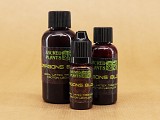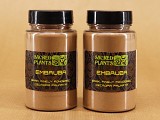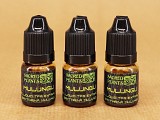Bark, Cut, 50 Gr from Brazil (SKU 4007)
Erythrina has long been used by the indigenous peoples in the Amazon. Tinctures and decoctions made from the leaves or barks of Mulungu.
50 gram roughly shredded Mulungu bark, harvested in Brazil.
| change currency | |||||||||
| SKU | Part | Form | Weight | Unit | Price | Qty
|
|||
|---|---|---|---|---|---|---|---|---|---|
| 4007 | bark | cut | 50 gr | 1 pc | $ 6.30 | ||||
| 5622 | bark | cut | 100 gr | 1 pc | $ 11.34 | ||||
| 5623 | bark | cut | 250 gr | 1 pc | $ 25.19 | ||||
| 5624 | bark | cut | 500 gr | 1 pc | $ 45.34 | ||||
| 5625 | bark | cut | 1000 gr | 1 pc | $ 85.65 | ||||
Erythrina has long been used by the indigenous peoples in the Amazon. Tinctures and decoctions made from the leaves or barks of Mulungu.
The chemicals in Mulungu have been studied extensively; they have been found to comprise large amounts of novel flavonoids, triterpenes, and alkaloids. The main plant chemicals in Mulungu include: alanine, arginine, aspartic acid, cristacarpin, cristadine, crystamidine, dimethylmedicarpin, erybidine, erycristagallin, erycristanol, erycristin, erydotrine, erysodienone, erysodine, erysonine, erysopine, erysotrine, erysovine, erystagallin A-C, erythrabyssin II, erythralines, erythramine, erythratine, eryvariestyrene, gamma-amino butyric acid, glutamic acid, hypaphorine lectins, n-nor-orientaline, oleanolic acid, oleanonic acid, phaseollidins, proteinases, sandwicensis, ursolic acid, and vitexin.
Other names: Erythrina mulungu
Mulungu is a medium-sized, well-branched tree that grows 10-14 m high. It produces a profusion of pretty, reddish-orange flowers (pollinated by hummingbirds) at the ends of the tree's many branches. The tree is sometimes called "coral flower," as the flowers resemble the color of orange coral. It produces black seed pods containing large, red-and-black seeds, which are sometimes used by indigenous peoples to make necklaces and jewelry. Mulungu is indigenous to Brazil, parts of Peru, and tropical areas in Latin America and, typically, is found in marshes and along riverbanks.
The Erythrina genus comprises more than 100 species of trees and shrubs (mostly all heavily armed with spines or thorns) in the topical and subtropical regions of both hemispheres. The mulungu tree (first recorded in 1829) is known by two botanical names, Erythrina mulungu and Erythrina verna. Another closely-related species, E. crista-galli, is used interchangeably in South American herbal systems and is found farther south on the South American continent. The flower of E. crista-galli is the national flower of Argentina.
Mulungu bark is traditionally used for its calming effects and has been used as an herbal remedy for anxiety, stress, and insomnia. It may also have other therapeutic uses, such as promoting heart health and aiding in the treatment of high blood pressure, though scientific research is still ongoing.
Decoction of Mulungu Bark:
Ingredients:
1-2 teaspoons of dried Mulungu bark (or as recommended based on your source)
2 cups of water
Steps:
Prepare the Bark:
If you are using dried Mulungu bark, ensure it is finely chopped or in small pieces to increase the surface area for extraction.
Boil the Water:
In a pot, add 2 cups of water and bring it to a boil.
Add the Bark:
Once the water is boiling, add the chopped Mulungu bark to the water.
Simmer:
Reduce the heat to a simmer. Let the mixture simmer for about 15-30 minutes, depending on how strong you want the decoction to be. Some prefer to simmer it longer for a more concentrated extract.
Strain the Decoction:
After the simmering time, remove the pot from heat. Strain the bark pieces from the liquid using a fine mesh strainer or cheesecloth.
Let it Cool:
Allow the decoction to cool down to a comfortable drinking temperature.
Optional:
You can sweeten the decoction with honey or another sweetener, depending on your taste preferences.
Consume:
The decoction can be consumed once or twice a day, typically after meals, but be sure to follow the recommended dosage or consult with a healthcare professional for personalized guidance.
Consult a professional before using Mulungu bark, especially for those with underlying health conditions or who are pregnant or breastfeeding.
Be mindful of the dosage; excessive use of Mulungu could have side effects. Always start with a small amount and observe any reactions.
Mulungu bark may cause drowsiness, so it's best to take it when you're not planning to drive or operate machinery.
This item is not allowed in the following countries:
Taiwan
This natural product is offered for its ethnographic and historical value and is delivered with no expressed or implied fitness for a specific purpose. It is simply a raw botanical specimen, or a scientific sample. The information provided is purely meant for historical, scientific and educational purposes and should never be interpreted as a recommendation for a specific use. The use and application of our product is at the customer's decision, responsibility and risk.
Read our Terms & Conditions for more details.


